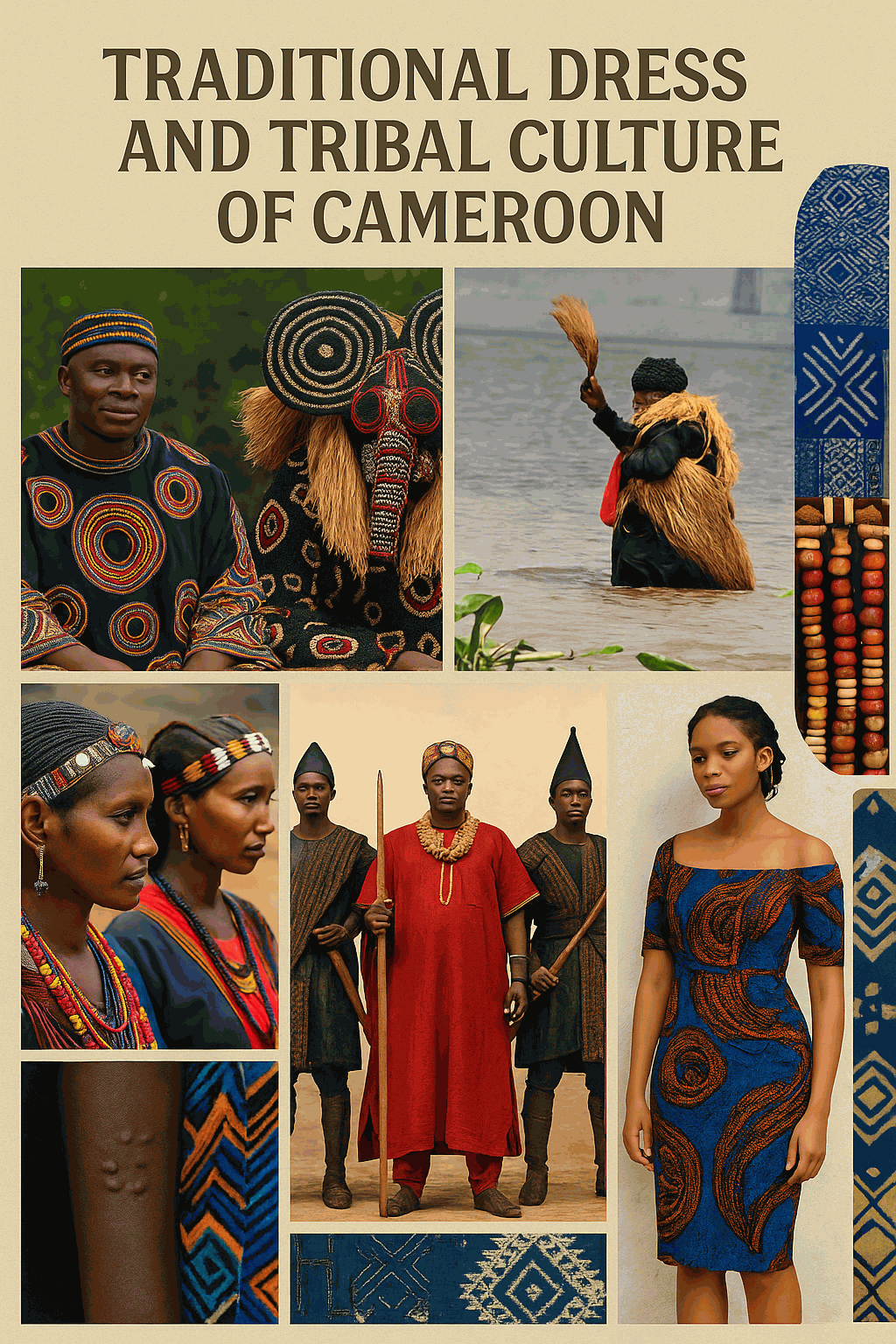Traditional Dress and Tribal Culture of Cameroon

Cameroon’s traditional dress and tribal culture reflect its incredible ethnic diversity, with over 250 distinct groups across the country. From the regal robes of Grassfields royalty to the colorful wraps of coastal communities, clothing in Cameroon is more than fashion—it’s a symbol of identity, status, and heritage, woven into ceremonies, dances, and daily life.
🔶 Overview of Cameroon’s Ethnic and Cultural Diversity
Cameroon is often called “Africa in miniature”—and for good reason. Within its borders, you’ll find a little bit of everything the continent has to offer: diverse landscapes, cultures, and traditions. The country is home to over 250 ethnic groups, each with its own language, customs, clothing, music, and way of life. From the Baka communities deep in the southeastern rainforests to the Fulani herders roaming the northern savannahs, Cameroon is a patchwork of fascinating cultures. These groups carry on rich oral traditions, celebrate vibrant festivals, and create art that speaks to centuries of history. And with English and French as official languages, layered on top of hundreds of local languages, the cultural diversity runs deep. For travelers who love exploring tradition, heritage, and everyday life, Cameroon offers an experience that’s as colorful as it is unforgettable.
🔶 The Significance of Traditional Dress in Cameroonian Identity
Traditional attire in Cameroon is far more than mere clothing; it's a powerful statement of identity, social status, age, and the specific occasion. The colors, patterns, and materials used in garments are imbued with deep symbolism, communicating tribal affiliation, individual wealth, and spiritual beliefs. For instance, specific patterns or colors can indicate a person's marital status, age, or membership in secret societies.
For example, the Toghu regalia of the Northwest Region, adorned with vibrant embroidery, is traditionally worn by royalty and during important ceremonies. In the northern regions, flowing robes and turbans reflect Sahelian influences, while in the west, the Bamileke people wear elaborately woven cloths for festivals and rituals. These garments are often reserved for special occasions such as weddings, funerals, and cultural festivals, where they help express respect, heritage, and community values. Wearing traditional attire is a way for Cameroonians to celebrate their roots and show unity in diversity, especially in a country with such a wide range of cultural expressions.
🔶 Major Ethnic Groups and Their Traditional Attire
Cameroon’s cultural richness is reflected in the traditional clothing of its major ethnic groups, each with styles that carry deep historical and social meaning.
a. The Bamileke (Western Highlands)
The Bamileke people are known for their vibrant and elaborate traditional attire, particularly their use of colorful woven garments and intricate beadwork. Ceremonial outfits often feature impressive elephant masks and heavily beaded regalia, which are significant in their cultural dances and rituals, such as the Nguon Festival and Toh.
b. The Fulani (North Cameroon)
In the northern regions, the Fulani, along with the Kotoko and Arab Choa peoples, are characterized by their flowing robes, elaborate turbans, and often intricate jewelry. These garments are practical for the arid climate and reflect dignity and tradition. Their nomadic customs, cattle herding, and strong Islamic influence are all subtly woven into their dress. Festivals like the Sahel Cultural Festival feature spectacular "fantasia" horse parades, where riders in vibrant attire and horses adorned with decorative cloths showcase bravery and heritage.
c. The Bakweri and Sawa Peoples (Coastal Region)
Along the coast, the Bakweri and Sawa peoples, particularly in Douala, utilize raffia garments for significant rituals, such as the Ngondo Festival. During this festival, participants in a symbolic canoe procession wear black, with one individual adorned in raffia or straw regalia, signifying a sacred or spiritual role during the journey to communicate with ancestors in the Wouri River. This highlights their marine-centered spirituality and ancestral reverence.
d. The Tikar and Bamoun (West/Central Region)
The Tikar and Bamoun peoples are renowned for their elaborate headdresses, exquisitely stitched tunics, and royal beadwork. These ornate pieces are prominently displayed during significant cultural events such as the Nguon festival and various Fon palace rituals, underscoring their rich royal heritage and artistic prowess.
e. The Baka and Bagyeli (Pygmy Forest Communities)
The Baka and Bagyeli, indigenous forest communities, traditionally wear minimal attire, often utilizing bark cloth and beads. Their deep forest traditions, hunting songs, and rich oral history are intrinsically linked to their way of life and the natural materials they use.
f. The Mafa and Mandara (Far North Region)
In the mountainous areas of the Far North, the Mafa and Mandara people wear layered, colorful clothing adapted to both cultural needs and climatic conditions. Their attire often includes bold patterns and practical accessories suited to the rugged terrain. Traditional festivals feature decorated gourds, beaded jewelry, and dances that reflect agricultural and ancestral themes.
g. The Kom People (Northwest Region)
The Kom are known for their distinctive blue and black woven garments called "Ndop", often worn during royal ceremonies and community events. The attire is typically paired with red caps and beaded accessories, symbolizing authority, wisdom, and social hierarchy. The Fon (king) and other nobles wear more elaborate versions to distinguish their status during traditional councils and festivals.
h. The Massa and Musgum (North Cameroon)
Located near the Chad border, the Massa and Musgum communities wear loose-fitting cotton robes and are famous for their traditional hairstyles and elaborate facial scarification, which are seen as marks of beauty and identity. During communal events, their dress is complemented by intricately decorated gourds, body paint, and colorful wraps.
i. The Ewondo and Beti (Central Region)
In the forested Central Region, the Ewondo and Beti people wear colorful kabas (long flowing gowns) for women and traditional tunics for men. These garments are typically worn during weddings, initiation ceremonies, and church events. Their use of patterned fabrics and coordinated outfits reflects communal unity and spiritual celebration.
j. The Mundang and Toupouri (Far North/Adamawa)
The Mundang and Toupouri peoples, known for their cattle culture and ritual dances, often wear wrap skirts and decorative headpieces made of cowrie shells and feathers. Their ceremonial attire is highlighted during dances that involve storytelling, drumming, and praise singing in honor of their ancestors and seasonal cycles.
Summary Table of Major Ethnic Groups and Their Traditional Attire in Cameroon
|
Ethnic Group |
Region |
Traditional Attire |
|
Bamileke |
Western Highlands |
Colorful woven garments, beaded regalia, and elephant masks; worn during royal rituals and festivals like Nguon and Toh. |
|
Fulani |
North Cameroon |
Flowing robes, turbans, and jewelry reflecting Islamic influence; featured in horse parades during the Sahel Cultural Festival. |
|
Bakweri & Sawa Peoples |
Coastal Region |
Raffia and straw garments used during the Ngondo Festival; symbolizes marine spirituality and ancestor worship. |
|
Tikar & Bamoun |
West/Central Region |
Ornate tunics, royal beadwork, and large headdresses; worn during palace events and the Nguon Festival. |
|
Baka & Bagyeli |
Forest Communities (South-East) |
Bark cloth and natural materials; minimalistic attire linked to forest life, hunting, and oral traditions. |
|
Mafa & Mandara |
Far North Mountains |
Colorful layered clothing with bold patterns; suitable for rugged terrain; featured in agricultural and ancestral rituals. |
|
Kom |
Northwest Region |
Ndop fabric in blue/black patterns, red caps, and beaded accessories represents nobility and is used in royal ceremonies. |
|
Massa & Musgum |
North Cameroon |
Cotton robes, facial scarification, decorated gourds, and body paint; worn during communal storytelling and dance. |
|
Ewondo & Beti |
Central Region |
Women wear long kabas, men wear tunics; outfits used during weddings, church services, and family gatherings. |
|
Mundang & Toupouri |
Far North/Adamawa Region |
Wrap skirts, cowrie-decorated headwear, and feathers; worn during ritual dances and seasonal celebrations. |
🔶 Fabrics and Materials Used in Traditional Dress
Cameroonian traditional dress utilizes a diverse array of natural materials including raffia, bark cloth, cotton, beads, feathers, and animal skins. These materials are often transformed through local weaving and dyeing techniques. While local cloths are prevalent, imported fabrics like Ndop, known for its indigo-dyed resist patterns, and Toghu, a richly embroidered fabric from the Grassfields, are also highly valued and incorporated into traditional garments.
🔶 Traditional Body Art and Jewelry in Cameroon Culture
Body art and jewelry play a crucial role in Cameroonian tribal cultures, serving as identity markers and spiritual symbols. Scarification, intricate beadwork, and various adornments are common. Ceremonial face painting, with its diverse patterns and colors, also carries specific meanings, often indicating rites of passage, social status, or participation in particular rituals.
🎶Dance, Music, and Dress: A Unified Cameroon Cultural Expression
Traditional attire is an integral part of Cameroonian dance and music, forming a unified cultural expression. The flowing movements of dancers are accentuated by their elaborate costumes, while the rhythmic beats of drums, the melodic sounds of xylophones, and the haunting tones of flutes accompany tribal rituals and celebrations. The visual spectacle of the dress enhances the auditory and kinetic experience of these cultural performances.
🌆The Influence of Modernity on Cameroon Traditional Dress
In contemporary Cameroon, there's a fascinating blending of tradition with modern fashion. While Western clothing is common for daily wear, traditional garments are proudly donned for festivals, ceremonies, and important social gatherings. Cameroonian designers are increasingly playing a vital role in preserving this rich heritage by incorporating traditional fabrics, patterns, and motifs into contemporary styles, ensuring that the country's sartorial legacy continues to evolve.
🔶 When and Where to See Cameroon Traditional Dress in Action
Traditional dress in Cameroon is most vibrantly showcased during cultural festivals, royal ceremonies, weddings, and national holidays. Major events like the Nguon Festival in Foumban, the Ngondo Festival in Douala, and the Sahel Cultural Festival in the Far North offer excellent opportunities to witness a variety of ethnic garments in their full splendor. Additionally, during National Day on May 20th, many communities across the country organize parades and cultural exhibitions where participants proudly wear their traditional attire. Visiting chiefdoms and palaces, particularly in the Western and Northwest Regions, also provides a chance to observe ceremonial dress during traditional councils or important visits. Whether in urban centers or remote villages, these occasions highlight the beauty, pride, and cultural identity expressed through traditional Cameroonian clothing.
Disclaimer: While this information was last updated in June 2025, we strongly suggest confirming all travel details with the appropriate governmental agencies, embassies, and airlines.
Applying for a Cameroon eVisa
- Step 1: Complete the online application form with your personal details and passport information.
- Step 2: Proceed to securely pay online using your credit card.
- Step 3: Check your email for payment confirmation and receipt of your Cameroon eVisa, which will be sent electronically.

